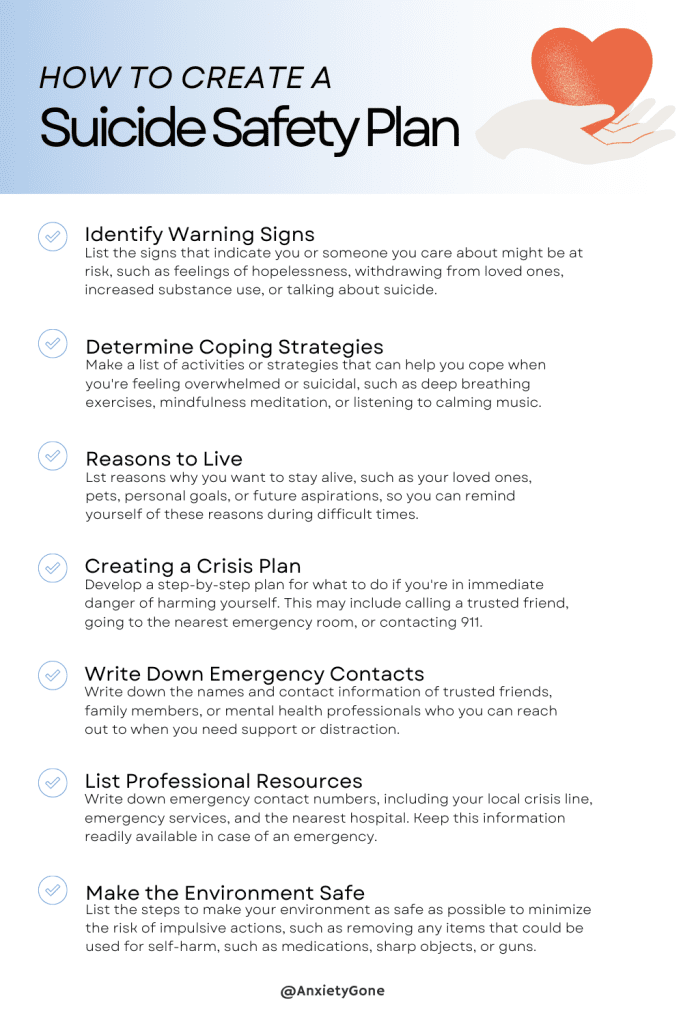Full Disclosure: Clicking on these links could mean a tiny commission for me, at no extra cost to you.
Experiencing suicidal thoughts can be overwhelming and isolating, but it is important to remember that there are ways to cope and find support. If you are looking for ideas on how to not kill yourself, or someone you know is struggling, this is for you. This guide offers compassionate advice and practical steps to help navigate these difficult feelings and find hope.
Ready to Break Free from Depression?
Ketamine therapy offers a breakthrough solution for those struggling with treatment-resistant depression. With Better U, you’ll receive a safe, guided at-home experience tailored to your needs — with compassionate support every step of the way.
Take the free assessment and discover if ketamine therapy could be the next step in your healing journey.
Reaching Out For Help
Before we go any further, if you are thinking about suicide or are struggling with feelings of hopelessness, it’s crucial that you reach out for help immediately. The 9-8-8 Suicide Crisis Hotline is open 24/7 and all you have to do is dial or text the number. They will walk you through the rest. You just have to take one step at a time; start with dialing or texting 9-8-8.
Reaching out for help is a vital step in learning how to not kill yourself. Speaking with a mental health professional, calling a suicide hotline, or confiding in a trusted friend or family member can provide immediate relief and a path toward healing. Remember, seeking help is a sign of strength.
Best Online Therapy Services of 2024
- Best for Availability: BetterHelp
- Best for Couples: ReGain
- Best for Psychiatry: Brightside
- Best for Teens: Teen Counseling
- Best for Anxiety and Depression: Brightside
- Best for LGBTQIA+: Pride Counseling
Understanding Suicidal Thoughts
Suicidal thoughts often stem from intense emotional pain, feelings of hopelessness, or mental health conditions like depression or anxiety. You might feel so upset, angry, and in pain that it seems like these emotions will never end. However, it’s important to remember that these feelings are temporary and will eventually pass, just like all emotions do.
There are steps you can take right now to learn how to not kill yourself and avoid acting on your suicidal thoughts and to even stop suicide in its tracks. Since everyone is different, it’s about discovering what works best for you.
How to Not Kill Yourself: 11 Things To Do Instead of Suicide
When you’re feeling overwhelmed by suicidal thoughts, it can be difficult to see a way out. However, taking proactive steps can make a significant difference. Remember, there is hope, and there are strategies that can help you learn how to not kill yourself and navigate through this tough time.
It’s important to remind yourself that these feelings are temporary, and with the right help and resources, you can overcome them. Your life is valuable, and there are countless possibilities ahead waiting for you to experience.
1. Talk to Someone You Trust
Isolation can make suicidal thoughts feel even more overwhelming and difficult to manage. It’s important to remember that you don’t have to face these feelings alone. Reach out to someone you trust, whether it’s a friend, family member, or counselor. Sharing your thoughts and emotions with someone who cares about you can provide immediate emotional support and help you feel less alone. Talking about what you’re going through can offer a new perspective and remind you that there are people who want to help you through this difficult time. Your feelings are valid, and finding a compassionate listener can be a crucial step toward healing.
2. Call a Suicide Hotline
Learning how to not kill yourself is all about reaching out to crisis hotlines such as the National Suicide Prevention Lifeline (1-800-273-TALK) or 9-8-8 are available 24/7 to offer support. Trained counselors are always ready to listen and provide immediate assistance. They can help you navigate your feelings and connect you with local resources to ensure you get the ongoing support you need.
Reaching out can be a crucial first step towards finding hope and comfort in a difficult time, and learning how to not kill yourself now or ever.
3. Create a Safety Plan
A safety plan is important when learning how to not kill yourself. This personalized plan is designed to provide structure and support during times of crisis. It might include a variety of coping strategies that appeal to your specific needs and preferences, such as breathing exercises, mindfulness techniques, or engaging in physical activity.
A suicide safety plan will also list emergency contact numbers, including friends, family members, and mental health professionals you can reach out to when you’re feeling overwhelmed. It’s important to have these numbers easily accessible so you can quickly get in touch with someone who can offer immediate support.
Additionally, your safety plan can outline specific steps to take when suicidal thoughts become intense. This might involve removing any items that could be used for self-harm from your immediate environment, identifying safe places to go if you need a change of scenery, and reminding yourself of reasons to stay alive, such as future goals, cherished memories, or the impact your life has on others.
Having a safety plan in place can provide a sense of security and control, helping you learn how to not kill yourself when times get tough. It serves as a reminder that there are effective strategies and supportive people available to help you cope.
advertisement
Reading to start healing?
Anxiety is treatable with therapy, and BetterHelp offers a convenient and affordable solution. With over 20,000 licensed therapists available, BetterHelp provides accessible care, starting at just $65 per week. Take a free online assessment today to get matched with the right therapist for you.
4. Get Your Body Moving
Although exercise is likely the last thing you feel like doing when you’re experiencing suicidal thoughts, it can be everything you need during a time like this. Engaging in some sort of physical activity can be an incredibly effective at managing emotional distress and improving your overall mood. This is because exercise stimulates the release of endorphins, the body’s natural mood lifters, which can help reduce feelings of anxiety and depression.
You don’t have to embark on a rigorous fitness regime to experience these benefits either. Even a simple walk in a nearby park can make a difference. Walking allows you to enjoy the fresh air, soak in the natural surroundings, and give your mind a break from overwhelming thoughts. The rhythmic nature of walking can also be meditative too, helping to calm your mind.
If you enjoy more vigorous activities, running or boxing can be an excellent option. It not only boosts endorphins but also helps you to release pent-up energy and stress.
Yoga is another powerful tool for managing emotional distress. The combination of physical postures, controlled breathing, and meditation can help you to reconnect with your body and mind, promoting relaxation and mental clarity. Yoga practice also encourages mindfulness, which can be particularly beneficial when dealing with intrusive thoughts and emotions. You can get a 50% discount on their yoga membership here.
5. Try a Mindfulness Activity
Mindfulness involves paying attention to the present moment without judgment. This can be as simple as focusing on your breath, the sensations in your body, or the sounds around you. Although you don’t want to feel the way you’re feeling any longer, practicing mindfulness can help you feel, process and heal what you’re feeling, so you can finally let those uncomfortable thoughts and emotions go. Mindfulness gives you the tools and knowledge needed, so you can break the cycle of negative thinking and bring your attention back to the here and now.
Here are some mindfulness activities you can do right now:
- Deep-Breathing Exercises: Focus on your breath, inhaling deeply through your nose and exhaling slowly through your mouth.
- Body Scan Meditation: Pay attention to each part of your body, from head to toe, noticing any sensations without judgment.
- Mindful Walking: Walk slowly and deliberately, focusing on the movement of your legs, the feel of your feet on the ground, and your surroundings.
- Guided Meditations: Use apps like Headspace or Mindfulness to follow guided sessions that help you focus and relax. Both are free (come back here for a discount if you’d like to upgrade).
- Gratitude Journaling: Write down three things you’re grateful for each day, focusing on positive aspects of your life.
- Mindful Eating: Eat slowly and savor each bite, paying attention to the flavors, textures, and sensations of your food.
- Sensory Awareness: Spend a few minutes noticing the sights, sounds, smells, and tactile sensations around you.
- Progressive Muscle Relaxation: Tense and then slowly release each muscle group, starting from your toes and working your way up.
Regular practice of mindfulness and meditation can help you build resilience against stress and anxiety, providing a steady anchor during difficult times. By dedicating just a few minutes each day to these practices, you can cultivate a greater sense of peace and stability, helping you navigate through emotional distress more effectively.
6. Take Some Slow Deep Breaths
Yes, even in this dire situation where you feel like you can’t go on any longer, I want you to stop, slow down and take some long deep breaths. Deep-breathing exercises are another effective way to practice mindfulness. Simple techniques like inhaling deeply through your nose, holding your breath for a few seconds, and then exhaling slowly through your mouth can activate the body’s relaxation response. This can help lower your heart rate, reduce tension, and calm your mind.
7. Repeat Affirmations to Break Free of Suicidal Thoughts
Using affirmations to overcome suicidal thoughts can be a powerful and uplifting practice.
Affirmations are positive statements that you repeat to yourself to challenge and overcome negative thoughts. When you’re experiencing suicidal thoughts, affirmations can help shift your mindset by reinforcing the belief in your own worth and the possibility of recovery. For example, repeating phrases like “I am valued and loved,” “This too shall pass,” or “I have the strength to overcome this” can help counterbalance feelings of hopelessness and despair. Over time, these positive messages can reframe your thinking, build resilience, and foster a more optimistic outlook on life.
Here are some other affirmations that can help with how you’re feeling right now:
- I am valued and loved.
- This pain is temporary and will pass.
- I have the strength to overcome this.
- My life has meaning and purpose.
- I am not alone; support is available.
- I am worthy of love and happiness.
- I trust that better days are ahead.
- I am a survivor, and I can get through this.
- There are people who care about me and want to help.
- I am more than my current thoughts and feelings.
- I have the power to change my thoughts.
- Every day is a new opportunity for healing and growth.
Consistently practicing affirmations can remind you of your inner strength and the potential for healing. And when you you find yourself searching for ideas on how to not kill yourself, go back to your affirmative statements.
Advertisement

8. Write Down Your Feelings
Journaling can be a therapeutic way to process your emotions, providing a safe and private space to express what you’re going through. Writing about your thoughts and feelings can help you gain clarity and perspective, making it easier to understand and manage your emotions. When you put your feelings into words, you can start to identify patterns and triggers, which can be crucial for recognizing and addressing the root causes of your distress and learning how to not kill yourself.
To get started, you don’t need to worry about writing perfectly or following any specific format. Simply begin by describing how you feel in the moment. You might write about what happened during your day, what emotions you experienced, and what thoughts crossed your mind. Over time, you can look back on your entries and see how your feelings have evolved, which can be encouraging and validating.
You might include drawings, suicide poems, or lists—whatever helps you express yourself most authentically. Some people find it helpful to write letters to themselves or to others, even if they never intend to send them. If you need some guidance on what to write, journals for depression are an excellent option.
9. Use Self-Harm Coping Techniques
If you’re experiencing urges to self-harm or struggling with suicidal thoughts, there are alternative coping techniques that can help you learn how to not kill yourself and manage these feelings in a safer way. These methods are designed to provide a physical sensation or emotional release without causing harm to yourself. Here are a few strategies you can try:
- Hold an Ice Cube
One effective technique is to hold an ice cube in your hand until it melts. Focus on the intense cold sensation. This can help divert your mind from the urge to self-harm and provide a similar physical experience without causing injury.
- Tear Something into Pieces
Another method is to take a piece of paper, an old magazine, or something else you don’t mind destroying, and tear it up into tiny pieces. The physical act of tearing can be cathartic and serve as an outlet for your emotions.
- Take a Cold Shower or Bath
Taking a very cold shower or bath can shock your system in a controlled way, which can help to interrupt the cycle of negative thoughts and self-harm urges. The intense sensation of the cold water can ground you in the present moment and provide a different physical stimulus.
- Use a Rubber Band
Wear a rubber band around your wrist and snap it gently when you feel the urge to self-harm. The slight sting can serve as a distraction and help to release tension without causing significant harm.
- Draw on Your Skin
Use a red marker to draw on the areas where you feel the urge to self-harm. This can mimic the visual aspect of self-harm without causing physical damage.
- Scream or Shout
Find a private space where you can scream, shout, or sing at the top of your lungs. Vocalizing your emotions can provide a significant release and reduce the internal pressure you might be feeling.
- Punch a Pillow
Direct your physical energy into something soft, like a pillow. Punching or squeezing a pillow can help release anger and frustration in a way that’s safe.
These coping techniques are meant to provide immediate relief and help you manage your urges in the moment. However, it’s also important to seek long-term support through therapy or counseling to continue learning how to not kill yourself. A mental health professional can help you explore the underlying reasons for self-harm and develop healthier coping strategies.
10. Find Reasons to Live
During difficult times, it might feel like the world would be better off without you or that there’s no point in living, but this is never the case. It’s crucial to remember that your life has intrinsic value and that there are numerous reasons to keep going, even if they are hard to see right now. Here are some strategies to help you reconnect with your reasons to live and learn how to not kill yourself:
- Reflect on Future Joys
Take some time to write down the things you’re looking forward to, no matter how small they might seem. This could be enjoying your favorite meal, visiting a loved one, or watching the next episode of a TV show you love. These moments of anticipation can serve as small beacons of hope.
- Make Enjoyable Plans
Plan something enjoyable for tomorrow or the near future. It doesn’t have to be a grand or expensive activity—sometimes, the simplest pleasures can have the most significant impact. Whether it’s a walk in the park, baking a favorite recipe, or spending time with a pet, these small plans can give you something positive to focus on.
- Consider Your Loved Ones
Think about the people who care about you and the impact your life has on them. Even when you’re feeling at your lowest, it’s important to remember that your loved ones would miss you deeply. Your presence is a source of joy and support for them, and they want you to be part of their lives.
- Write a Gratitude List
Create a list of things you are grateful for. These can be big things like supportive friends and family, or small things like a sunny day or a good book. Focusing on gratitude can help shift your perspective and remind you of the positive aspects of your life.
- Visualize a Positive Future
Spend a few minutes each day visualizing a positive future for yourself. Imagine achieving your dreams, overcoming obstacles, and living a fulfilling life. This practice can help create a mental shift towards hope and possibility.
Take the Next Step Toward Recovery
Ketamine therapy is a breakthrough option for those struggling with depression when other treatments haven’t worked. Backed by science and guided by experts, this at-home experience can help you regain control of your mental well-being.
11. Seek Professional Help
Sometimes, finding your reasons to live can be challenging without professional support. While talking to a therapist or counselor is highly beneficial, there are also other avenues of professional help available that can provide you with the support and strategies you need to cope.
Online therapy platforms like BetterHelp and Brightside Therapy, provide access to licensed therapists and counselors via chat, video, or phone. These services can be more flexible and accessible, especially if in-person visits are challenging.
Advertisement
⚡ Access Treatment Right Now
→ Online Therapy – Talk to a licensed therapist today through BetterHelp. Affordable, private, and convenient therapy starting at $65/week. Take the Free Assessment to get matched now.
→ Digital Psychiatry – Connect with a provider in 12–48 hours via Hims/Hers. Explore FDA-approved medication options — no insurance required. Get Started Today.
You can also look for workshops, seminars, or webinars focused on mental health and wellness. These educational sessions can provide valuable information, coping strategies, and a sense of empowerment. You can read a self-help book on how to not kill yourself. Or try DIY therapy by following the prompts in a Cognitive Behavioural Therapy journal, such as the popular Therapy Notebook.
Final Thoughts on How To Not Kill Yourself
Remember to be kind and practice self-compassion. Understand that it’s okay to feel what you’re feeling and that you are doing your best. Treat yourself with the same kindness and understanding that you would offer a friend. And even when it feels like there’s no point in going on, there are countless reasons to keep living. Your presence is valuable, and the world is a better place with you in it. Seeking help and finding small joys can lead to brighter days ahead. You are important, and your life is worth living.
FAQs
- What should I do if I’m experiencing suicidal thoughts? Reach out for help immediately. Talk to someone you trust, call a suicide hotline, or seek professional support. You don’t have to go through this alone.
- How can I help a friend who is experiencing suicidal thoughts? Listen without judgment, offer support, and encourage them to seek professional help. Ensure they know you care and are there for them.
- Are there any apps that can help with suicidal thoughts? Yes, apps like Headspace, Mindfulness, and Crisis Text Line can offer immediate support and coping strategies.
- What are some signs that someone might be considering suicide? Warning signs include talking about wanting to die, withdrawing from activities, increased substance use, and changes in mood or behavior. Take these signs seriously and offer support.
- How can I find a therapist who specializes in suicidal thoughts? Look for therapists with experience in treating depression, anxiety, and suicidal ideation.
- Is it normal to have suicidal thoughts? While it’s not uncommon to experience suicidal thoughts, it’s important to seek help. These thoughts are a sign that you need support and there are effective treatments available.










